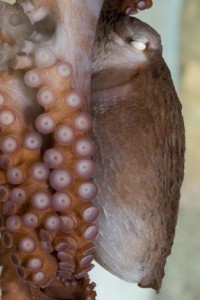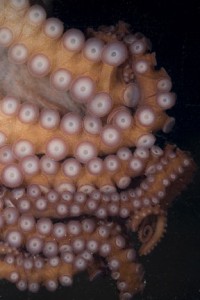Squid pro quo
At a mere three pounds, the National Zoo’s new giant Pacific octopus (Enteroctopus dofleini) doesn’t appear to have earned its name. Yet not only will it grow to be more than 13 times its current size over the next year, it will also play a big role in teaching researchers and recruiting fans.
“The new octopus will help us continue to excite people about invertebrates, which make up more than 95 percent of the animal kingdom,” said Alan Peters, the Zoo’s curator of invertebrates. “The giant Pacific octopus is the ‘giant panda’ of invertebrates—it may get the most attention, but we can use it to lure visitors into a world of incredible insects, spiders, corals and so much more.”
Giant Pacific octopuses emerge from eggs only a little larger than a grain of rice, but as adults can weigh hundreds of pounds in the wild, with an arm span of up to 25 feet. The Zoo’s octopus, which arrived at the end of January and will be named this month, appears to be male, Peters said. But at a mere 2 ½ years of age, it may take more time before the Zoo can confirm the animal’s gender.
Octopuses are mollusks—related to squid, cuttlefish and nautiluses—and can change their color and texture instantly with a signal from their brains.
Scientists have also discovered that octopuses are natural explorers. The Zoo will use its octopus to learn about such behavior by introducing enrichment objects and observing whether the octopus becomes more active as a result. Although the new octopus is the only one currently at the National Zoo, Peters and his team have conducted similar research on at least six of the Zoo’s past octopuses.
“For an invertebrate, the octopus is very responsive,” Peters said. “We have a chance to look at a new octopus that has not yet experienced the enrichment that we provide. Once we do introduce those objects, we’ll be able to add to our dataset and increase the strength of our conclusions.” Follow the octopus’ growth spurt and enrichment activities by watching on the octopus cam or visiting the National Zoo’s Invertebrate Exhibit.
Posted: 16 March 2010
- Categories:






I think it’s so fascinating that octopus can squeeze through any space as large as its beak (which is tiny in comparison to its overall size). Tammy’s daily Octopus demo is also a must see!
I really enjoy the sense of humor you put into these articles. It’s silly, but “Squid pro quo” really made me laugh!